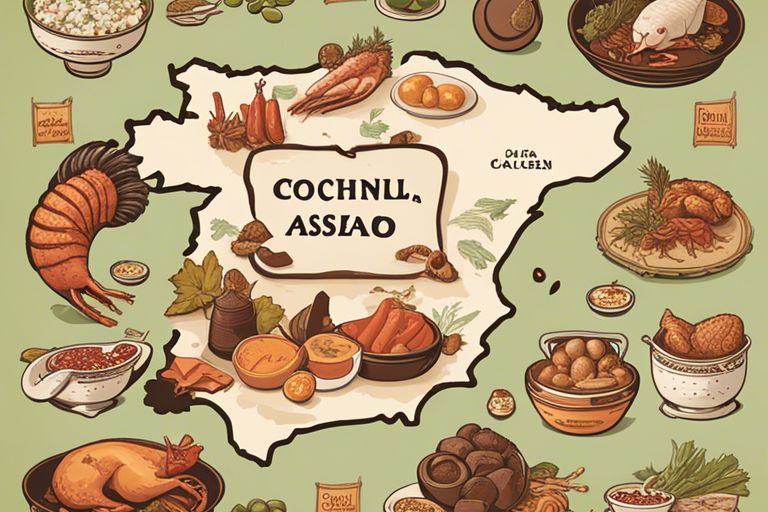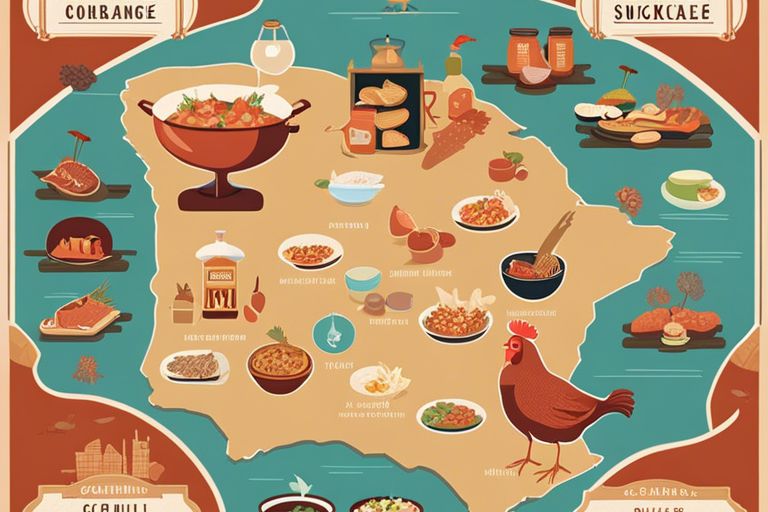Just beyond the usual tapas and paella, Spain boasts a plethora of rare and unique food delicacies waiting to be discovered. From the coastal regions to the mountains, Spanish cuisine offers a rich tapestry of flavors and ingredients that are sure to tantalize the taste buds of adventurous food enthusiasts. Join us as we take a deep investigate the world of rare Spanish food delicacies, uncovering hidden gems and culinary treasures along the way.
Key Takeaways:
- Preserved Tuna Belly (Mojama): A delicacy made from salt-cured tuna belly, providing a unique umami flavor.
- Iberian Ham (Jamón Ibérico): Highly prized cured ham from acorn-fed Iberian pigs, known for its rich and complex taste.
- Cantabrian Anchovies: Considered some of the finest anchovies in the world, these hand-filleted fish deliver a delicate and savory experience.
The Charcuterie Tradition
If you are an adventurous food enthusiast looking to explore rare Spanish food delicacies, then stepping into the world of charcuterie is a must. The art of charcuterie in Spain has a rich history dating back centuries, showcasing the culinary prowess of the country’s artisans in preserving and transforming meats into delectable cured products.
Jamón Ibérico: The Crown Jewel
With its unparalleled flavor and exquisite marbling, Jamón Ibérico is often hailed as the crown jewel of Spanish charcuterie. Made from the meat of free-range Iberian pigs that roam the oak forests of Spain, this cured ham undergoes a meticulous curing process that can last for years. The result is a melt-in-your-mouth delicacy with a complex flavor profile that reflects the pigs’ acorn-rich diet.
Embutidos: Beyond the Common Chorizo
Embutidos encompass a wide variety of cured sausages and meats that go beyond the popular chorizo. From the spicy sobrasada of Mallorca to the delicate salchichón, these exotic embutidos offer a diverse range of textures and flavors that can tantalize the taste buds of any charcuterie aficionado. Each region of Spain boasts its own unique embutidos, showcasing the cultural and gastronomic diversity of the country.
Exotic Embutidos: Beyond the Common Chorizo
If you are looking to research deeper into the world of exotic embutidos, consider exploring the traditional Iberico lomo. Made from the lean pork tenderloin of the Iberian pig, this cured meat is seasoned with a blend of spices and aged to perfection. The result is a succulent and flavorful delicacy that embodies the essence of Spanish charcuterie craftsmanship.
Seafood Specialties
Now, let’s look into the world of rare Spanish seafood delicacies. From the rugged coastline of Spain, unique seafood specialties have emerged that offer a taste of the sea like no other.
Gooseneck Barnacles: A Rugged Delight
With their distinctive long, black stalks and the briny, intense flavor they possess, gooseneck barnacles are truly a delicacy for those with an adventurous palate. These peculiar-looking crustaceans are harvested from the rocky shores of Galicia, where brave fishermen risk life and limb to gather them from the treacherous cliffs where they cling.
Gooseneck barnacles are often enjoyed simply boiled or steamed, allowing their natural flavors to shine. Their unique texture and taste make them a sought-after delicacy in high-end seafood restaurants and a must-try for any seafood enthusiast looking to experience something truly extraordinary.
Asturian Cider-Steamed Clams
On the northern coast of Spain in Asturias, cider-steamed clams are a beloved specialty that combines the region’s famous sidra (cider) with fresh clams from the nearby waters. The marriage of the briny shellfish with the sweet and tangy cider creates a delectable dish that showcases the flavors of the sea and the land.
Rugged cliffs and crashing waves provide the backdrop for the traditional preparation of Asturian cider-steamed clams, where the clams are cooked in cider until they open, releasing their juices and infusing the dish with a remarkable depth of flavor. This unique dish is a testament to the coastal traditions and culinary heritage of the Asturian region.
Regional Cheese Varieties
Your journey through the rare Spanish food delicacies would be incomplete without delving into the world of regional cheese varieties. Spain boasts a rich cheese-making tradition with unique flavors and textures that vary from region to region. Let’s explore some of the most prized Spanish cheeses that are a must-try for any cheese connoisseur.
The Pungent World of Cabrales
The land of Asturias in northern Spain is home to one of the most iconic and intense blue cheeses in the world – Cabrales. Made from a blend of cow’s, sheep’s, and goat’s milk, this cheese is aged in natural caves where the blue mold cultures work their magic, creating a pungent and complex flavor profile. The result is a cheese with a creamy texture punctuated by bold and sharp blue veins that pack a powerful punch.
The distinct aroma and bold flavor of Cabrales make it a favorite among cheese lovers who appreciate strong cheeses. Pair it with a glass of Spanish cider or a robust red wine to fully experience its unique taste and character.
Flor de Guía: The Wrapped Wonder
An emblematic cheese from the Canary Islands, Flor de Guía stands out for its distinctive presentation – wrapped in a strip of cloth that gives it a rustic and charming appearance. This semi-hard cheese is made from cow’s milk and boasts a smooth and buttery texture with a slightly tangy flavor profile. The cloth wrapping not only adds to its visual appeal but also helps regulate the cheese’s moisture levels, allowing it to mature gracefully.
Flor de Guía is a versatile cheese that can be enjoyed on its own, paired with fruits and nuts, or used in cooking to add depth and richness to dishes. Its unique wrapping technique sets it apart from other cheeses and adds a touch of authenticity to any cheese board.
Singular Sweets and Desserts
Unlike the familiar flan or churros often associated with Spanish cuisine, there are some rare and unique delicacies that tantalize the taste buds of those seeking something special. In this chapter, we investigate into the world of singular sweets and desserts that showcase the culinary creativity of Spain.
Tocinillo de Cielo: Divine Custard
To start our exploration, let’s indulge in the heavenly treat known as Tocinillo de Cielo. This traditional Spanish dessert translates to “little bacon from heaven,” and it certainly lives up to its divine name. Made from rich egg yolks, sugar, and water, this custard-like delicacy melts in your mouth with a luscious sweetness that is simply irresistible. Tocinillo de Cielo is often served in small portions, making it a perfect ending to a sumptuous Spanish meal.
Turrones with a Twist: A Modern Take
With a twist on the classic Spanish nougat, modern Turrones offer a contemporary spin on this traditional treat. While the original Turron is made with almonds and honey, the modern version incorporates innovative flavors such as chocolate, citrus fruits, and even exotic spices. These reinvented Turrones continue to honor the essence of the original recipe while adding a touch of creativity and novelty to satisfy the evolving palates of dessert enthusiasts.
Sweets like Turrones with a modern twist are a testament to the dynamic culinary landscape of Spain, where traditional recipes are reimagined to captivate contemporary tastes. This fusion of tradition and innovation reflects the vibrant spirit of Spanish gastronomy, where the past and the present converge to create delightful culinary experiences.

Final Words
As a reminder, exploring rare Spanish food delicacies is a fascinating journey into the rich culinary heritage of Spain. From the exotic flavors of jamón ibérico to the unique taste of percebes, each dish tells a story of tradition and culture. It is important to appreciate and savor these rare delicacies as they provide a glimpse into the diverse and vibrant world of Spanish cuisine. So, whether you are a seasoned food enthusiast or a curious newcomer, do not hesitate to launch on this culinary adventure and discover the delicious treasures that Spanish gastronomy has to offer.
FAQ
Q: What are some examples of rare Spanish food delicacies?
A: Some examples of rare Spanish food delicacies include Jamón Ibérico, a type of cured ham made from Black Iberian pigs, percebes, also known as goose barnacles, and angulas, which are baby eels.
Q: Where can I find these rare Spanish food delicacies?
A: These rare Spanish food delicacies can be found in specialty gourmet shops, high-end restaurants, and markets in regions of Spain known for their culinary expertise such as Basque Country, Catalonia, and Andalusia.
Q: Are rare Spanish food delicacies expensive?
A: Yes, due to their unique production methods and limited availability, rare Spanish food delicacies can be quite expensive. For example, Jamón Ibérico can cost hundreds of dollars per pound, while angulas can be one of the most expensive delicacies in the world.

